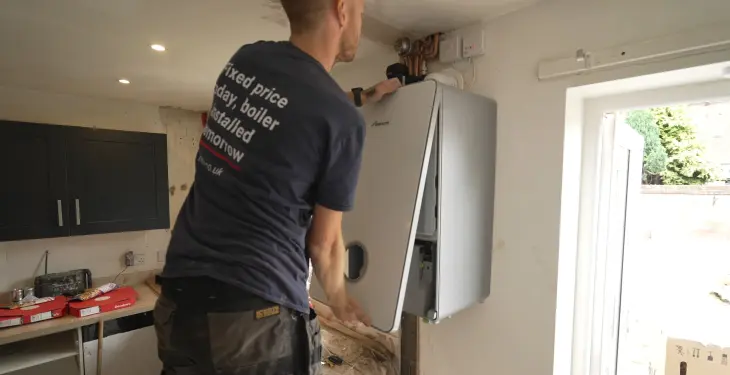

Written by Stephen Day
Gas Safe Engineer
Updated: 30th May, 2025
From adding insulation to sealing gaps, there are both DIY and professional methods available to achieve a quieter boiler cupboard. Some approaches are simple and cost-effective, while others may require a bit more investment and effort.
Get a new boiler quote, save up to £550 per year (0% APR available).
A noisy boiler cupboard can be a real nuisance, turning what should be a peaceful home into a constant source of irritation. Soundproofing your boiler cupboard can significantly reduce noise levels, making your living space much more comfortable. Whether the sound is a low hum or a more disruptive clanging, there are several strategies you can use to minimise it effectively.
From adding insulation to sealing gaps, there are both DIY and professional methods available to achieve a quieter boiler cupboard. Some approaches are simple and cost-effective, while others may require a bit more investment and effort. Understanding the common causes of boiler noise and how to address them can empower you to make the best decision for your needs.
Soundproofing doesn't have to break the bank. Various solutions cater to different budgets and requirements, allowing you to choose the one that best fits your situation. Armed with the right information, you can decide how to approach soundproofing your boiler cupboard and ensure a more serene environment in your home.
Get a quote in 60 seconds, fitted as fast as next day!
0% APR finance available.
Boilers can be noisy for many reasons, and understanding these causes can help in fixing the problem.
One common cause of boiler noise is air in the system. When air gets trapped inside the pipes, it can create a gurgling or hissing sound. Bleeding the radiators can often solve this issue.
A build-up of limescale can also cause low-frequency noises. This often happens in areas with hard water. The limescale collects on the heat exchanger and other parts, causing banging or kettling sounds.
Another cause is the boiler pump. When it’s not working correctly, it may produce a humming or grinding noise. This can be temporary fixed by gently tapping the pump, but it usually requires a more thorough cleaning or replacement.
Loose or worn-out components, such as bearings and fans, can lead to rattling or whining noises. Keeping these parts well-maintained is crucial.
Water pressure can also impact the noise levels. Low pressure can cause a buzzing sound, while high pressure might create a banging noise. Make sure the boiler pressure is within the recommended range.
The quality of installation also plays a role. Poor installation can lead to structure-borne noise, where vibrations travel through walls and floors.
Impact noise can occur when parts inside the boiler move suddenly. This might sound like a bang or a thump, and often indicates that something is wrong internally.
Regular maintenance is essential to prevent and address these issues. A Gas Safe Engineer should be consulted for persistent or worrisome noises.
To effectively soundproof a boiler cupboard, use a mix of DIY techniques and professional materials. Specific methods such as applying acoustic panels, plasterboard, and fibreglass insulation can reduce noise. Additionally, inspecting the door and surrounding areas for gaps and sealing them properly is essential.
Acoustic panels are an excellent way to absorb and reduce the noise from a boiler. They are often made from foam or fibreglass, which captures and dampens sound waves. Position these panels on the walls and the door of the boiler cupboard. Secure them with strong adhesive or command strips. This helps minimise reverberation and ensures that the sound does not travel to other parts of the house.
Acoustic plasterboard, also known as soundproof drywall, is denser than regular plasterboard. It helps to block sound transmission due to its high mass. Attach it to the walls inside the boiler cupboard using screws and acoustic sealant to fill any gaps. Adding a layer of acoustic plasterboard can significantly improve the sound insulation of the cupboard.
A soundproof blanket or curtain is a straightforward solution. These are designed with materials like fibreglass and mass-loaded vinyl to block and absorb sound. Hang them inside the boiler cupboard, ensuring they cover the entire area. Use weatherstripping around the edges to create a tight seal, which helps in reducing noise leakage.
An easy and cost-effective method is to use sheets and towels. Store them inside the cupboard to absorb sound naturally. This technique works by adding mass and softness to the space, which disrupts sound waves. It's best suited for small, enclosed cupboard spaces and can be combined with other soundproofing methods for better results.
Fibreglass insulation is highly effective in reducing noise due to its density and flexibility. Install fibreglass batts or rolls in the walls around the boiler. This material not only absorbs sound but also offers thermal insulation. Ensure the insulation is tightly packed, and consider adding an outer layer of acoustic plasterboard for additional soundproofing.
The door is a crucial point for sound leakage. Seal any gaps around the door frame with weatherstripping. Adding a door sweep at the bottom can block gaps between the door and the floor. Attach a layer of acoustic foam or a soundproof blanket to the door itself to further reduce noise.
Creating a stud wall inside the boiler cupboard and filling it with insulation can be very effective. Use materials like rockwool or mineral wool batts for insulation. These materials absorb sound and prevent it from travelling through the walls. Cover the insulated studs with acoustic plasterboard to complete the soundproofing process.
In some cases, moving or replacing an old boiler might be more efficient than soundproofing. Modern boilers are often quieter and more efficient. If the boiler is particularly loud and outdated, consider consulting a professional to evaluate whether a new, quieter model would be a better solution.
Soundproofing a boiler cupboard can range in cost based on materials and methods. Here's a breakdown of potential expenses:
1. Acoustic Foam Panels
Cost: £10-£50 per panel
Details: These are commonly used for insulating walls and reducing noise. They're easy to install using adhesive.
2. Mass-Loaded Vinyl (MLV)
Cost: £2-£5 per square foot
Details: MLV is a dense material effective at blocking sound. It's often layered on walls or doors.
3. Weatherstripping
Cost: £5-£15 per roll
Details: This can be used around the door to seal gaps and reduce noise leakage.
4. Door Sweeps
Cost: £10-£30 each
Details: Installed at the bottom of the door, door sweeps can help block noise that escapes through this gap.
5. Installing Shelves with Towels/Sheets
Cost: Minimal, if using existing linens
Details: Placing soft items like towels and sheets inside the cupboard can help absorb sound.
6. Labour Costs
Cost: £20-£50 per hour (if hiring a professional)
Details: While many soundproofing tasks can be DIY, hiring a professional ensures correct installation.
Item | Estimated Cost |
5 Acoustic Foam Panels | £50 - £250 |
10 sq ft MLV | £20 - £50 |
2 Rolls Weatherstripping | £10 - £30 |
1 Door Sweep | £10 - £30 |
Labour (3 hours) | £60 - £150 |
Total | £150 - £510 |
Costs can vary widely depending on the materials chosen and the complexity of the installation. Choosing premium materials will increase the initial cost but may result in better soundproofing.
Get a quote in 60 seconds, fitted as fast as next day!
0% APR finance available.
Last updated: 30th May, 2025

Written by Stephen Day
Gas Safe Engineer at iHeat
Stephen Day is a Gas Safe registered and FGAS certified engineer with over 20 years of hands-on experience in the heating, cooling, and renewable energy industry, specialising in boiler installations, air conditioning, and heat pump systems.
LinkedInArticles by Stephen Day are reviewed by iHeat’s technical team to ensure accuracy and reliability.

22nd December, 2025
Based on data from over 7000 boiler installations completed by iHeat in the past 12 months...
 Read Article
Read Article

22nd December, 2025
Here’s a quick roundup of the best combi boilers for 2026.
 Read Article
Read Article

22nd December, 2025
When your old boiler breaks down and it comes time to replace it with a new one, it might...
 Read Article
Read Article
No obligation. Takes less than 60 seconds.